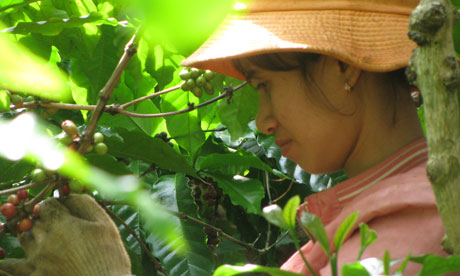 | |
| Ripe coffee cherries ready for picking on a Rainforest Alliance certified farm in Vietnam/Veronique Mistiaen |
I recently went to the central highlands region of Vietnam to look at the terrible environmental cost the country is paying for its spectacular coffee growth over the past two decades. Now the country is trying to undo the damages and put itself on a more sustainable path.

A better future is percolating for Vietnam's coffee
The spectacular growth of coffee in Vietnam came at a terrible environmental cost. Now conservation groups are working with food multinationals to ensure quality and sustainable production

A coffee picker from the ethnic minority Edê. Photograph: Veronique Mistiaen
The velvety coffee slowly dripping from the filter into my glass is bitter and dark. But once mixed with the sweet, silky condensed milk at the bottom, it turns into a rich chocolaty brew. It is a fitting metaphor for the story of coffee in Vietnam.
French colonists introduced coffee here in 1857. The central highlands region – known as Buon Ma Thuot – proved a perfect area for growing robusta beans. But a century later, the Vietnam war devastated the country and coffee production was severely disrupted.
After the long war, the government, supported by development agencies, launched a vast coffee-growing programme in the region to help put the country on the road to recovery. Its success has been astonishing.
In just two decades, Vietnam went from the scorched earth of Agent Orange to become the second coffee exporter in the world after Brazil, and the number one for robusta – one of the two main coffee species, often used in instant coffee. (Arabica, the other main variety, is grown at a higher altitude and comprises about 75% of world production).
This spectacular comeback has been a huge boon to the economy – coffee is Vietnam's key export, generating an income of more than $1.5bn. In total, the coffee sector represents 3% of national GDP, providing a livelihood for around 2.6 million people – 600,000 of them farmers and many from minority ethnic groups. Only 5% to 7% of the total production is used for domestic consumption; the rest is exported, mostly to the US and Europe.
But the coffee miracle has come at a terrible cost. In the 1990s, when coffee price was high, entire forests were razed to make space for more coffee, grown as a monoculture with heavy use of agrochemicals and over-irrigation. While the acreage under coffee expanded rapidly, the development of training and processing infrastructure could not keep up.
The proliferation of poorly managed coffee farms (coffee in Vietnam is mostly grown on small family-run farms of two to five acres), where beans were cultivated with little regard for the environment, resulted in a glut of low quality beans that drove export prices down, contributing to the global collapse of coffee prices in the 2000s. It has also caused widespread pollution, soil and water degradation, habitat destruction and loss of biodiversity in one of the most biologically diverse countries in south-east Asia.
 |
| Coffee pickers with their harvest after a long day of work/Veronique Mistiaen |
Aside from the catastrophic impact on the environment and the quality of its beans, coffee in Vietnam is now facing new challenges, such as adaptation to climate change, a younger generation not wanting to be farmers and a global market changing from oversupply with record low prices to supply shortage with high prices (and as China and India are developing a taste for coffee, the demand is likely to skyrocket).
These issues are so critical that, for the first time, the government, farmers, traders and global food giants see the need to develop sustainable practices. They are working with social and conservation groups such as the Rainforest Alliance, the 4C Association and the Fairtrade Foundation to find ways to make coffee farming more productive, while reducing the cost on the environment.


